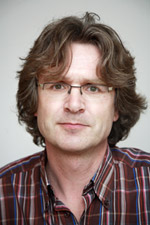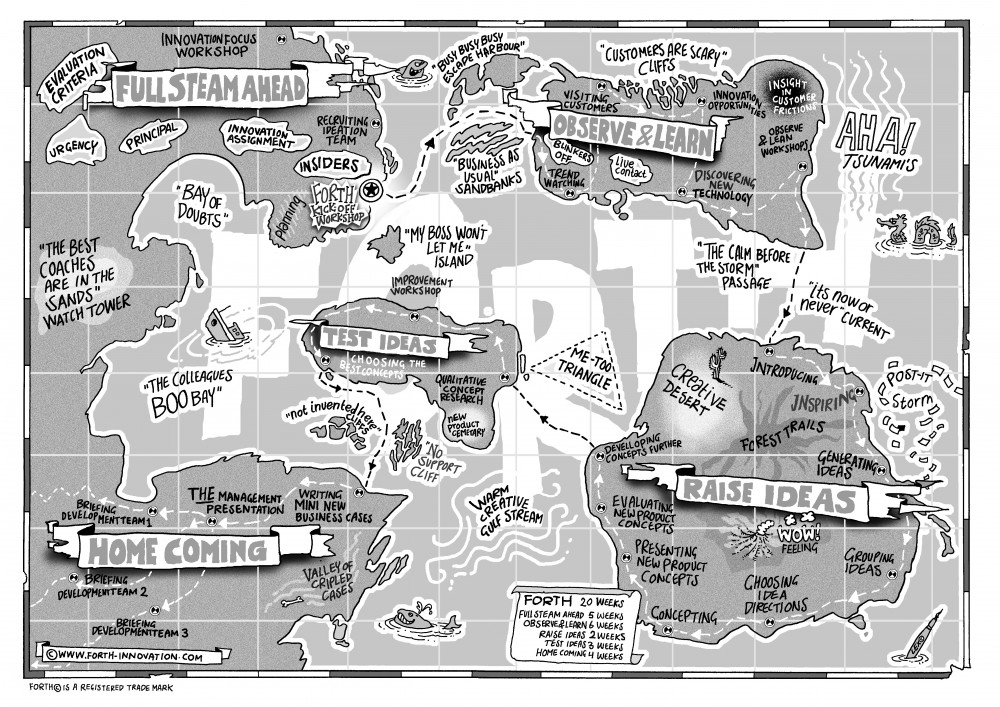By: Gijs van Wulfen
The fuzzy front end of innovation confronts you with a lot of questions. In my new book ‘Creating innovative Products and Services’ I try to solve them. This time I like to introduce a structured ideation method, which combines both creativity and business reality.
In my last blog on Innovation Management I discussed five dilemmas in the ideation phase. I advised you to:
- start ideation only when there is a real business need;
- use a team approach;
- start with a concrete innovation assignment;
- define clear criteria;
- use both creativity and structure in your process.
But HOW do you do this in practice?
I developed a structured creative ideation approach called FORTH. It is a customer oriented inspiring method to create mini new business cases for innovative products, services and business models. The FORTH innovation method has been used in Europe by business-to-business and business-to-consumer companies and non-profit organisations for five years.
FORTH connects creativity and business reality. To think outside the box is a good start. But you have to come back with innovative concepts, which fit the ‘in the box’ reality of your organisation, otherwise nothing will happen. In the method an innovation goes an expedition. FORTH is an acronym and stands for Full steam ahead, Observe and learn, Raise ideas, Test ideas and Homecoming.
Stage 1: Full steam ahead
A good preparation increases the chance of success. First you determine the purpose and direction of the ideation phase in an innovation assignment. And you determine the criteria the innovative concepts must comply to. The second important decision is to determine how your ideal ideation team looks like. The bigger the team, the greater the diversity and the greater the chance of wild, crazy, pattern breakthrough ideas. A special mission asks for special people. That’s why top managers are also part of the innovation team. At the FORTH kick-off workshop an enthusiastic multidisciplinary team is ready to go.
2. Observe and learn
There are no old roads to new solutions. That’s why it is essential to get fresh insights. That is the essence of stage two. Who is the potential customer and what motivates and frustrates him or her? That’s key. In this phase you get to know the customer and his or her behaviour. All team members will visit customers themselves. Besides customers, others serve as a source of inspiration for the innovation opportunities, identified in the kick-off. Ask yourself the question “If we want to innovate in this direction, from whom can we learn?” This way you look for the best practices and valuable experiences of other persons or organizations involved with these opportunities.
Team members share their insights and lessons learned in several ‘Observe and learn’ workshops in this phase. The exploration take place in six weeks. At the end, the ideation team gained relevant new customer insights and has explored interesting innovation opportunities.
3. Raise Ideas
This step is the creative ‘pièce de résistance’ of FORTH. It consists of an intensive two-day brainstorm of innovative concepts. The ideation is inspired by the discovery stage and team members cannot wait to share their ideas. This leads often to six hundred ideas or even more. They are converged into 40 idea directions and twelve concrete concept statements. In a second session the concepts are taken a step further and are improved. External experts are invited to strengthen the team. And cartoonists are available to take care of the first designs.
4.Test Ideas
How attractive are the new product or service concepts really? That’s a legitimate question. Therefore you reflect on the concepts immediately. The strength of the new concepts is checked among potential customers. This research, on a small scale, can be done quickly and simultaneously in several countries or continents, with ‘live’ customers or online. First reactions from potential customers often offer excellent handles for improvement. Another workshop takes place in which the team brainstorms how weak spots can be fixed. Having concepts tested in this early phase creates the advantage that you can use the ‘Voice of the Customer’ to gain internal acceptance for the concepts later on in the stage-gate process. At the end of this phase it is decided which concepts are worked out as mini new business case in the last phase.
5 Home coming
In the final stage of FORTH you bring home the souvenirs of the innovation trip. It is not a bunch of yellow post-its or mood boards. Instead the innovative concepts are worked out as mini new business cases. These are business plans per concept elaborating on essential business elements as: the attractiveness of the new concepts to the target group, the sales and profit potential, how the concept fits in the business strategy and whether realising it is considered feasible. Presenting end results in this form creates a lot of appreciation in the boardroom. A business case is something top management will recognise and understand. The activities in this last stage cover around four weeks. At the end of this fifth – and final – stage the ideation team has completed its tasks. In practice it takes you around fourteen weeks after the kick-off to return with four mini new business cases.
User feedback on this structured ideation approach shows that the strength of a structured ideation approach like the FORTH innovation method is in 5 aspects:
- The innovation assignment at the start gives clear focus and expectations,
- The team discovers relevant customer insights themselves,
- The best innovative concepts are approved by customer,
- You return with four practical mini new business cases
- The team approach creates internal support (at the top level).
With a structured ideation approach like FORTH, you can jumpstart innovation. You can download thirteen checklists on the FORTH innovation method for free. I wish you a lot of success on your own ideation expeditions.
About the author:
 Gijs van Wulfen (The Netherlands, 1960) is the founder of the FORTH innovation method. FORTH is an effective and structured method for ideating innovative products and services. The method is published in his inspiring and practical book Creating Innovative Products and Services’ (Gower, 2011).
Gijs van Wulfen (The Netherlands, 1960) is the founder of the FORTH innovation method. FORTH is an effective and structured method for ideating innovative products and services. The method is published in his inspiring and practical book Creating Innovative Products and Services’ (Gower, 2011).
He helps organisations to kick start innovation by facilitating the FORTH innovation method and advising companies on their innovation strategy, process and organisation. His clients are international companies in industry and services, as well as non-profit organisations in government and health. Gijs also trains facilitators in his method. His dream is to make FORTH the most used method for the front end of innovation around the world.
Gijs is a both presenter and chairman at several (international) innovation conferences, like the ISPIM Conferences and the European Conference on Creativity and Innovation. He is also founder of the yearly Dutch Innovation Conference on creating new products: ‘Nieuwe Producten Bedenken’.

